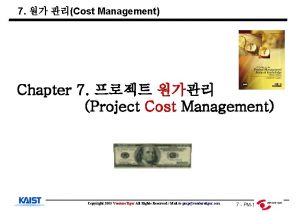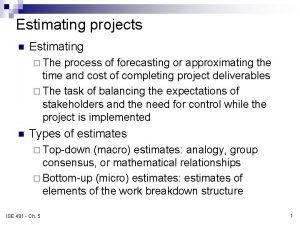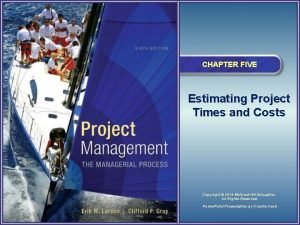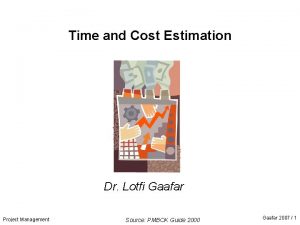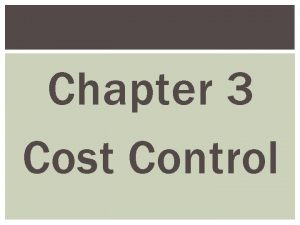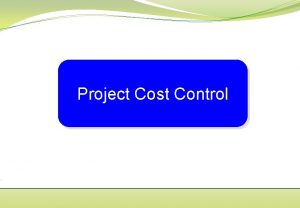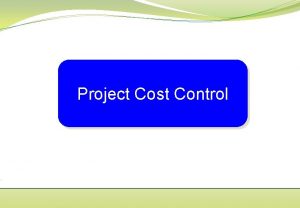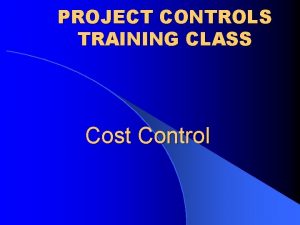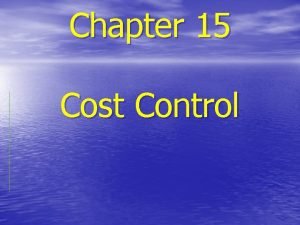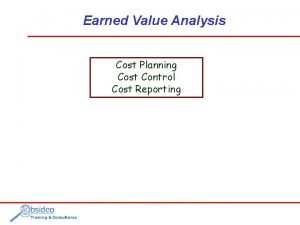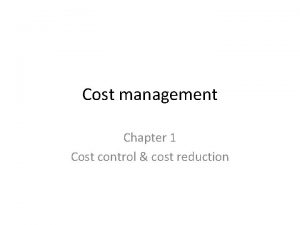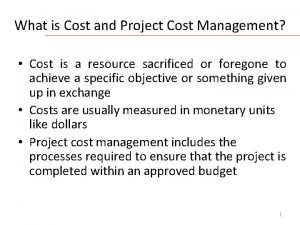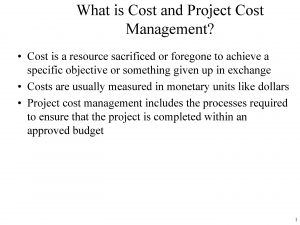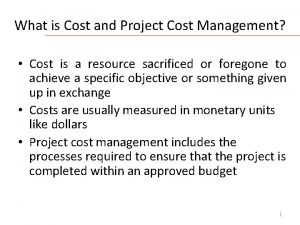Cost and Time Control Project completed on time














- Slides: 14

Cost and Time Control

• Project completed on time and on budget – Want to get done early – Lower costs – More profit

Cost Control • Use cost codes assigned to items during estimating – Cost codes allow PM to monitor costs and compare to estimated costs – Want total project under budget

Cost Control – Uses of actual data • Monitor costs, id problem areas, select mitigation measures • Id additional costs incurred thru change in scope • Id costs for completing work that was subbed out (back charges) • Develop a database of historical data for estimating future projects • Provide a cost report to owner

Cost Control – Steps involved • Assign cost codes to each element of work in cost estimate • Correct estimate based on buyout costs • Actual costs are tracked using cost codes • Construction process is adjusted to reduce cost overruns • Actual quantities, costs, and productivity rates are recorded and as built estimate is prepared

Cost Control – Greatest risk items • Direct labor • Equipment usage or rental • Job site overhead or project admin – Need detailed cost analysis to see where overruns are

Cost Codes • Need to be able to track actual vs estimated costs – Use same coding as on files – Many companies use CSI Master. Format system • Proj #. CSI Workpackage. element of cost • 1 = labor, 2 = equipment, 3= materials, 4 = sub • 9821. 06100. 1 – labor for rough carpentry on Huna Office Bldg

Accounting • Usually done at home office – All cost items have cost code – Must be right cost code even if it means you go over budget on item • Only way to truly track how you are doing

Work Packages • Method of breaking down estimate into distinct packages or systems that match measurable work activities • Footings including forms, rebar, pour is a work package • Get supers involved in estimating the work packages that they will oversee

Project cost curve • Graph showing estimated labor vs actual labor – Actual Labor under estimated => either beating estimate or behind schedule – Actual Labor over estimated => either over estimate or ahead of schedule – Track those activities which are critical or carry the highest labor – F 16 -4 work package cost control

Management reports • Need to develop a monthly forecast for project – Direct labor, direct material, major purchase order items, subs, job site admin, equip rental, {taxes, permits, insurance}, Fee – Each gets a separate page with a 1 page summary of project – F 16 -5 – Need to keep on top of costs

AS Built estimate • Important historical tools • Especially important on unit price estimates

Schedule control • Monitoring progress of each activity – Determine impact of delayed activities on completion – Need to ensure substantial completion by contract date – Should do an as built schedule - historical

Earned value • Technique for determining estimated and budgeted time of work completed to date • On work package curve put in curves for actual man-hours and earned value – Earned value = man hours worked time % complete F 16 -6, 7 – Gives a measure of productivity • Subtract actual time used from time scheduled – horizontal dist • Subtract actual cost from earned value of work performed – vertical line
 Cost control and cost reduction project report
Cost control and cost reduction project report Cost control and cost reduction project report
Cost control and cost reduction project report Cost control and cost reduction difference
Cost control and cost reduction difference Cost control and cost reduction difference
Cost control and cost reduction difference How is informal language different from formal language
How is informal language different from formal language Project cost control
Project cost control Estimating project time and cost
Estimating project time and cost Top down budgeting vs bottom up budgeting
Top down budgeting vs bottom up budgeting Estimating project time and cost
Estimating project time and cost Crashing a project example
Crashing a project example Lotfi gaafar
Lotfi gaafar Cost accumulation and cost assignment
Cost accumulation and cost assignment Cost accumulation and cost assignment
Cost accumulation and cost assignment Cost pools
Cost pools Cost accumulation and cost assignment
Cost accumulation and cost assignment





